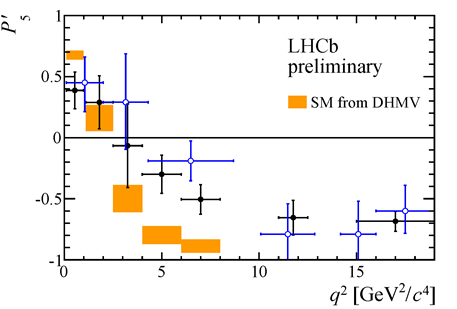Angular analysis of the B0→K*μ+μ– decay.
Today at the 50th Rencontres de Moriond Electroweak, in La Thuile (Italy), the LHCb collaboration presented the result of a first full angular analysis of the B0→K*μμ decay using its full LHC run 1 data sample. A previously published analysis of the experiments 2011 data sample found a deviation with respect to a calculation based on the Standard Model, see 9 August 2013 news. The particle physics community has been eagerly awaiting the results from the full data sample ever since.
The analysis of the B0→K*μμ decay is considered as a very promising way to search for effects of yet undiscovered particles, see the 14 June 2013 news for an introduction. Unfortunately, the analysis of this decay is also complicated; the best sensitivity to the new particles comes from the study of the angular distribution of the muons and the kaon and pion from the K* meson decay. Physicists from the LHCb experiment have studied different angular observables as functions of the mass of the muon pair. It was one of these observables, “P5‘“, that showed a local deviation with respect to the Standard Model calculation (at a level of 3.7σ in the mass squared of the muon pair region q2 from 4.3 to 8.68 Gev2/c4). There is particular interest in these observables because their theoretical prediction is much less dependent on a good understanding of the hadronic physics involved in turning a B meson into a K* meson (so called form-factors). These observables are therefore ideal for searching for the effects of new particles in this decay.
The image shows the distribution of the P5’ observable as functions of the mass squared of the muon pair q2. The black points show the LHCb results presented for the first time today. The Standard Model predictions are presented as orange boxes. These were taken from calculations described in a recent theoretical paper. The behaviour seen in the 2011 data sample, shown as the blue points for comparison, is confirmed using the full data set. The measurements in the q2 region between 4 and 8 GeV2/c4 are both 2.9σ from the Standard Model calculation.
The results of the analysis of the B0→K*μμ decay will continue to attract the attention of the particle physics community in the coming years. In the next couple of years, the LHCb collaboration will improve the precision of their analysis with the help of data collected in run 2 of the LHC. It is also anticipated that the theoretical predictions (the orange regions in the image) will improve in precision. Theorists will be busy trying to make sense of this measurement, and seeking for possible associations with other unexpected effects found in similar decays, for example the RK anomaly (see 3 June 2014 news). Stay tuned for future developments on this page.
Read more in the LHCb presentation at La Thuile, in the LHCb conference note, in the CERN news, in the CERN Courier article, in theoretical physicists’ blogs here and here, in the theorist’s comment in the CERN Courier and in the LHCb paper.

